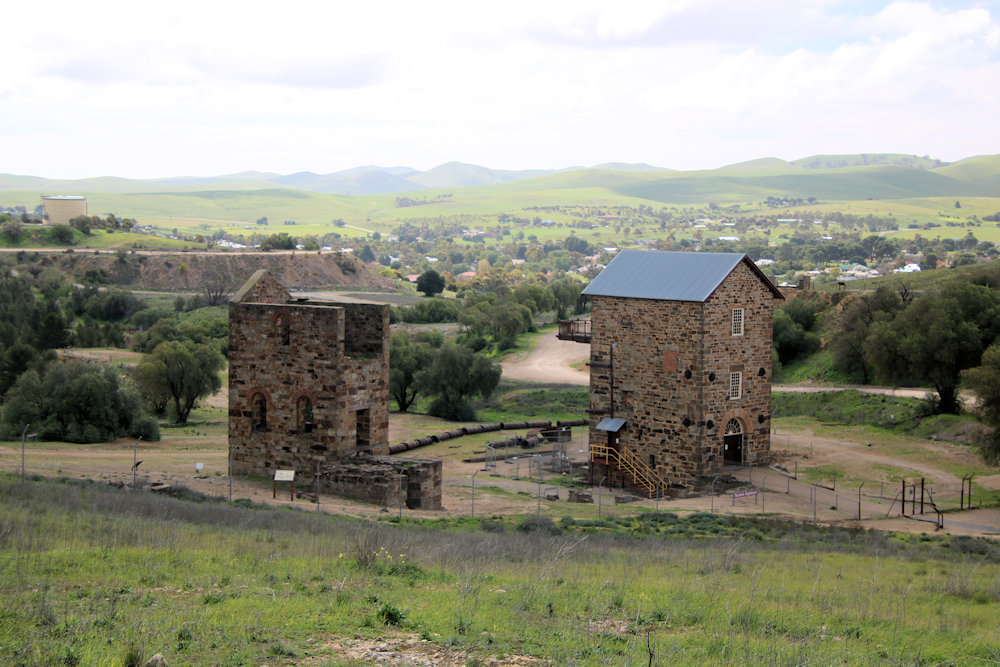Burra Mine South Australia
The Burra Mine, often referred to as the “Monster Mine,” is one of the most important historic mining sites in Australia. Situated at Burra in South Australia, it was once among the largest copper mines in the world and played a vital role in the economic survival of the fledgling colony of South Australia. Between the mid-1840s and the 1870s, the mine drew thousands of workers—many of them skilled Cornish miners—and transformed Burra into a thriving industrial hub. Today, the remains of the mine, from its open cut to its stone engine houses and surrounding heritage landscape, form part of the Burra State Heritage Area and attracts visitors eager to explore its legacy.
Discovery and Establishment
Copper was discovered near Burra in 1845, sparking immense interest in the mineral-rich district. Rival groups of investors competed to secure the rights, and eventually, the “Monster Mine” was taken up by the South Australian Mining Association (SAMA). This venture brought together groups of businessmen and settlers who pooled resources to purchase land and establish the mine.
From the outset, the mine proved remarkably rich. The ore body, stretching for over seven kilometres, contained deposits of high-grade copper that could be extracted with relative ease in the early years. The success of the Burra Mine ensured that the colony’s finances were stabilised during a period of crisis, earning it the nickname “the mine that saved South Australia.”
Operations and Workforce
Mining commenced in 1845 and initially involved traditional underground methods using picks, shovels, and blasting powder. As production increased, the workforce expanded rapidly, with up to 1,000 men employed at the mine during its peak years. Skilled Cornish miners formed the backbone of operations, bringing with them expertise in hard-rock mining and the use of steam-powered equipment.
Life for workers was tough. Conditions underground were hot, cramped, and dangerous, with limited ventilation and risks from rockfalls or flooding. Miners were paid according to the quantity and quality of ore raised, creating both incentive and pressure. Supporting the miners were labourers, smelter workers, engineers, and tradesmen, alongside women and children who sustained domestic life in surrounding settlements such as Hampton Village and Redruth.
Infrastructure and Technology
The Burra Mine soon became a showcase for mining technology in Australia. Massive Cornish-style engine houses were constructed to accommodate beam engines that pumped water from the underground workings and raised ore to the surface. These structures, built of local stone, remain as some of the most iconic ruins on the site today.
Ore was initially smelted locally, but smelting proved uneconomic, and much of the raw ore was shipped overseas, particularly to Wales, for processing. Horse whims, tramways, and crushing machinery were installed to improve efficiency. The scale of operations, combined with the mine’s profitability, made Burra a leader in Australian mining for several decades.
Community and Cultural Impact
The Burra Mine was not just an industrial operation but also the heart of a diverse community. Migrants from Cornwall, Wales, Scotland, and Germany settled in Burra, each bringing their own customs and traditions. Cornish influence was particularly strong, seen in architecture, food, religious practices, and even dialect.
The mining boom created a patchwork of settlements around the mine, including Redruth, Aberdeen, Hampton, and New Aberdeen. These villages provided housing for miners and their families, chapels, schools, and basic amenities. Together they formed the town of Burra, which became one of the largest inland settlements in Australia during the 1850s.
Decline of the Mine
By the late 1860s, the Burra Mine’s output had begun to dwindle. The easily accessible surface ore was depleted, and the costs of deeper underground mining rose significantly. At the same time, international copper prices dropped due to new sources of supply, particularly from Chile and the United States.
In 1877, after three decades of operation, the mine was closed, leaving behind a vast network of underground tunnels, machinery, and surface works. Many miners and their families left to seek work in other South Australian copperfields, notably Moonta and Kadina, or migrated further afield to Victoria and overseas.
The Site Today
The Burra Mine site is one of the most atmospheric and visually striking parts of the Burra heritage landscape. Visitors can see the open cut, the remains of stone engine houses, chimney stacks, powder magazines, and other industrial relics. Interpretive signage explains the layout and function of various buildings, and walking trails guide visitors through the ruins.
The mine is preserved as part of the Burra Heritage Passport scheme, which allows visitors access to key sites across the district. Unlike a working museum, the Burra Mine is maintained as a ruin, offering a raw and authentic insight into the scale and ambition of 19th-century mining.
Visiting the Burra Mine
- Access: Entry is via the Burra Heritage Passport, obtainable at the Burra Visitor Information Centre.
- Experience: The site is open-air and best explored on foot, with walking shoes recommended. Early morning or late afternoon light enhances the textures of the stone ruins.
- Facilities: Minimal facilities are provided at the site; visitors should bring water and sun protection.











To find more things to see and do in South Australia, click here.
Our photos are available for purchase on

Leave a Reply